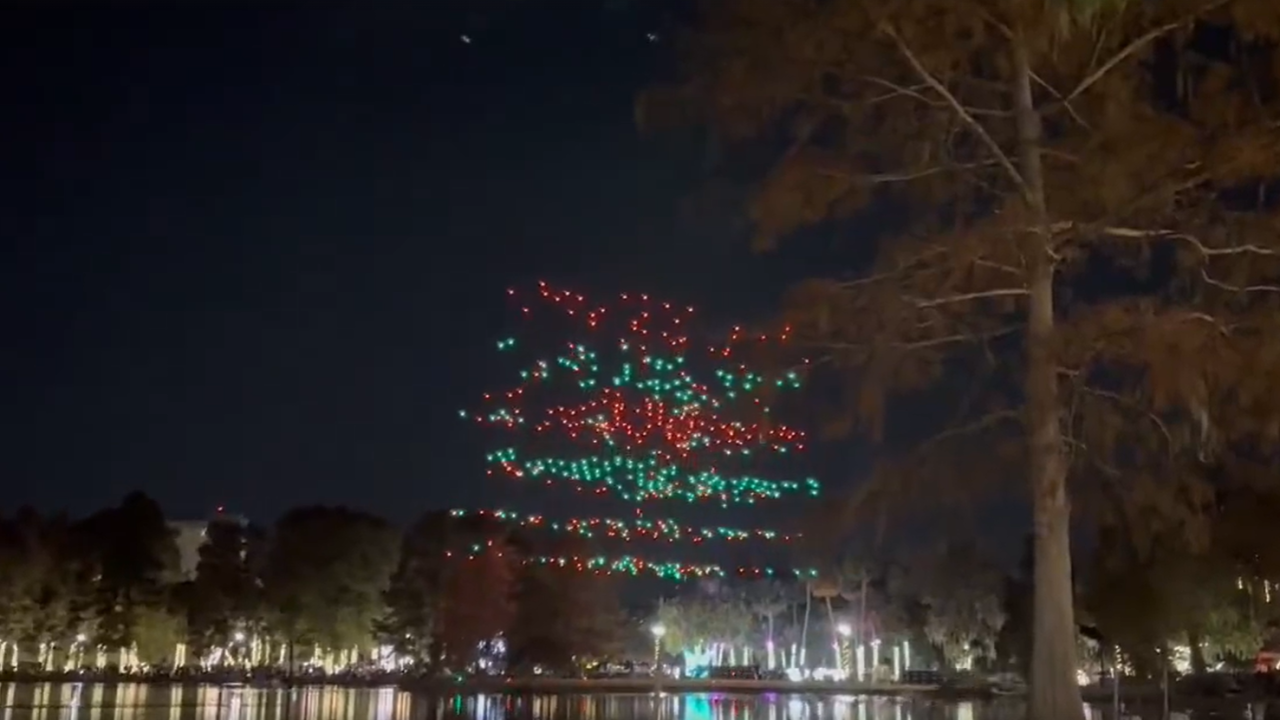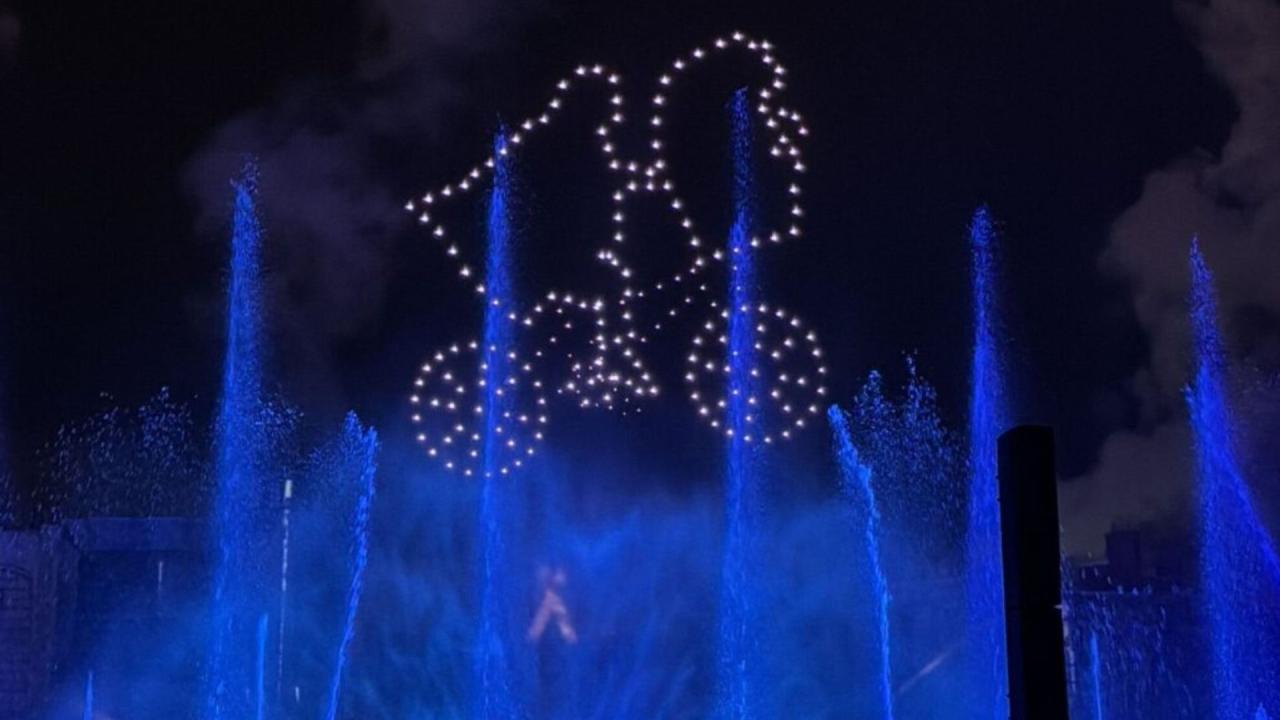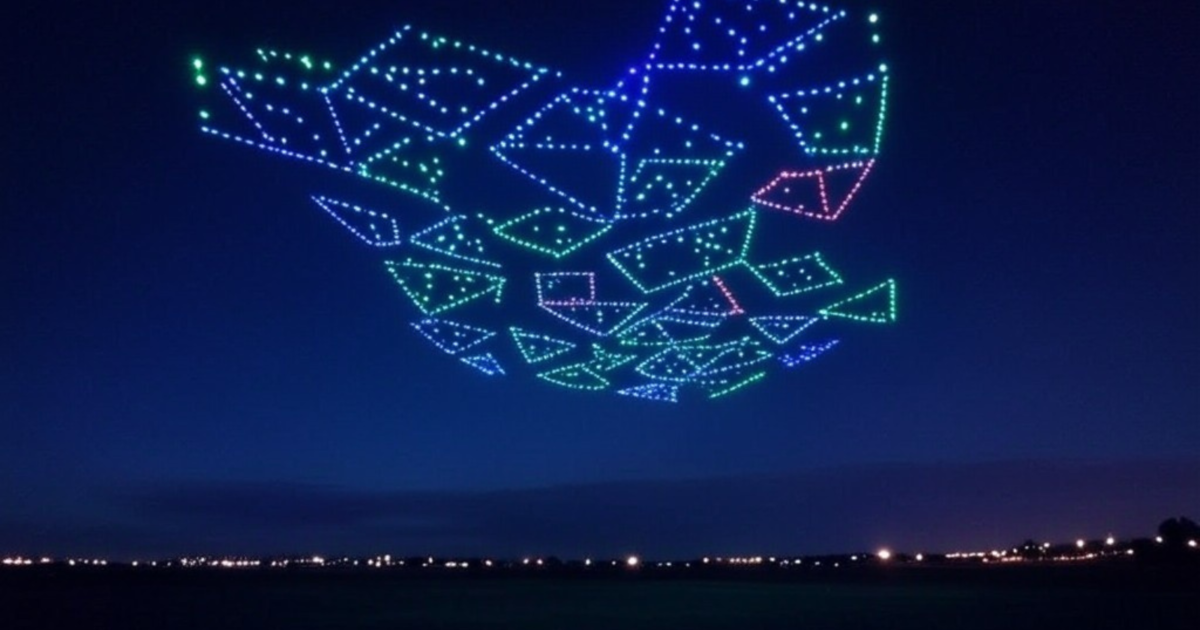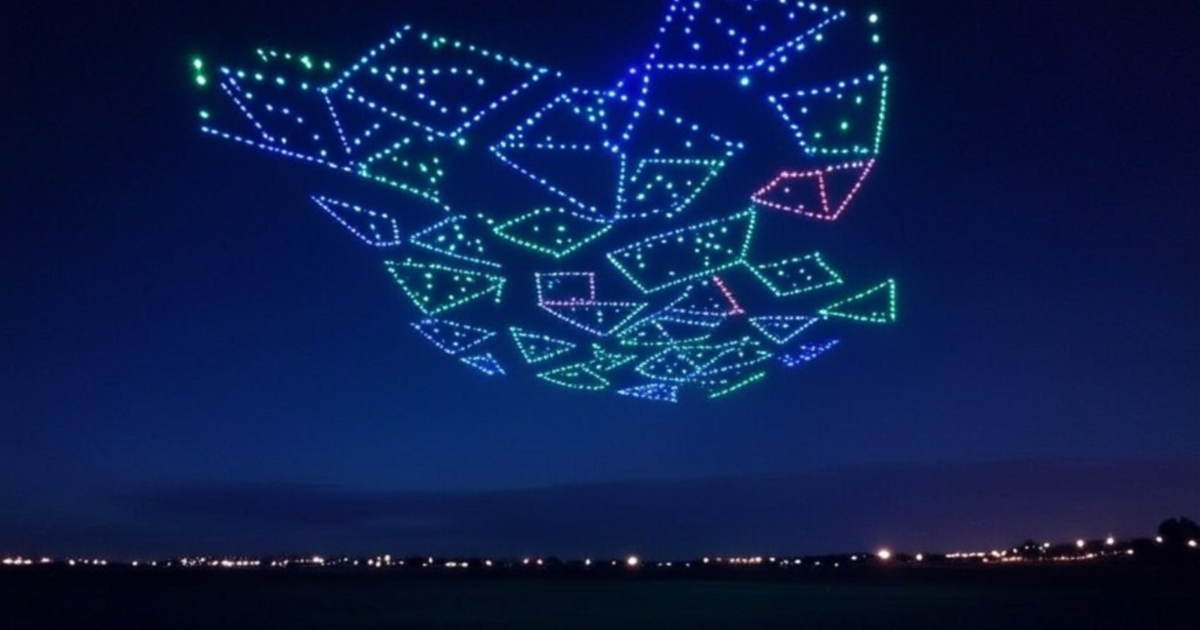Orlando drone show accident: A spectacular nighttime drone display turned unexpectedly chaotic, leaving spectators and authorities scrambling to understand what went wrong. This incident highlights the crucial need for robust safety protocols and regulatory oversight in the rapidly expanding world of drone technology. We’ll delve into the specifics of the accident, examining the events leading up to it, the resulting damage, and the subsequent investigation.
This report will cover everything from the types of drones involved and the extent of any injuries to the regulatory compliance issues and the ongoing investigation. We will also explore the public’s reaction and the media coverage, along with potential preventative measures to avoid similar incidents in the future. The analysis will consider insurance implications and legal liability for all involved parties.
Accident Overview
The Orlando drone show accident involved a malfunction during a large-scale public display of unmanned aerial vehicles (UAVs). While the exact cause is still under investigation, preliminary reports suggest a combination of factors contributed to the incident, highlighting the complexities of coordinating numerous drones in a dynamic environment. This section details the circumstances, timeline, and affected parties involved.
Drone Specifications and Types
The drone show utilized a fleet of commercially available quadcopter drones, likely customized with specialized lighting and software for synchronized flight patterns. While the exact model numbers haven’t been publicly released by the organizers, it’s reasonable to assume they were high-end models capable of carrying significant payloads for the impressive light shows they were designed to create. These drones typically feature GPS modules for precise positioning, sophisticated flight controllers for autonomous maneuvers, and high-capacity batteries for extended flight times.
The size and weight would likely have varied depending on their role in the overall display. Some drones might have been larger and carried more powerful lighting systems, while others could have been smaller and more agile for intricate maneuvers.
Timeline of Events
The following table provides a chronological account of the events leading up to and including the accident. Note that this is based on preliminary reports and may be subject to revision as the investigation progresses.
| Date/Time | Event Description | Location | Affected Parties |
|---|---|---|---|
| [Date and Time – Show Start] | Drone show commenced as scheduled, with initial flight patterns proceeding normally. | [Specific Location in Orlando] | Show organizers, drone operators, spectators |
| [Date and Time – Malfunction Begins] | Reports indicate a group of drones deviated from their programmed flight path. | [Specific Area within Show Location] | A subset of the drone fleet, potentially affecting the overall display |
| [Date and Time – Collision/Crash] | Several drones collided with each other and/or the ground. | [Specific Area within Show Location] | Damaged or destroyed drones, potential minor property damage |
| [Date and Time – Show Halted] | The drone show was immediately halted, and emergency protocols were initiated. | [Specific Location in Orlando] | Show organizers, drone operators, spectators, emergency services |
| [Date and Time – Aftermath] | Emergency personnel responded to assess the situation and secure the area. | [Specific Location in Orlando] | Show organizers, drone operators, spectators, emergency services, investigators |
Circumstances Surrounding the Accident
Several factors may have contributed to the Orlando drone show accident. These include potential software glitches in the drone’s flight control systems, interference from external sources (such as radio frequency signals), or unforeseen environmental conditions (e.g., strong winds). The investigation will need to determine the precise cause and contributing factors to prevent similar incidents in the future. The complexity of coordinating a large number of drones simultaneously increases the probability of a malfunction in one or more units affecting the entire system.
This underscores the need for robust safety protocols and redundancy measures in large-scale drone operations.
Injuries and Damages
The Orlando drone show accident, while spectacular in its visual impact, unfortunately resulted in several injuries and a significant amount of property damage. The severity of the consequences varied considerably, depending on proximity to the crash site and the nature of the affected property. Understanding the full extent of these impacts is crucial for assessing the overall implications of the event and for informing future safety regulations surrounding large-scale drone operations.The incident resulted in a range of injuries, from minor scrapes and bruises to more serious fractures and lacerations.
Emergency responders reported treating at least fifteen individuals on-site, with three requiring hospitalization for more extensive treatment. One individual sustained a moderate concussion and another suffered a fractured leg requiring surgery. The precise number of injuries might increase as some individuals might experience delayed symptoms or seek medical attention later. Fortunately, no fatalities were reported.
Extent of Injuries
The injuries sustained were largely consistent with the impact of falling debris from the drone show. Smaller pieces of the drone and associated pyrotechnics caused superficial wounds, while larger components resulted in more significant injuries. The injuries varied in severity, depending on factors such as the size and weight of the debris, the impact velocity, and the location of impact on the individual.
Medical professionals on-site provided immediate first aid, and a triage system was quickly implemented to prioritize treatment based on injury severity. Follow-up care was provided to those discharged from the hospital, and long-term rehabilitation plans were put in place for individuals with more serious injuries.
Property Damage Assessment
The drone crash caused considerable property damage. Several vehicles parked near the show’s viewing area sustained significant damage, including dented roofs, shattered windshields, and broken lights. At least five cars were deemed to be write-offs, requiring complete replacement. Additionally, the impact caused damage to nearby buildings, including broken windows and damaged siding. A small section of a nearby park’s fence was also destroyed.
Cost Estimates
Estimating the total cost of repairs and replacements is a complex process. Initial estimates place the cost of vehicle repairs and replacements at approximately $250,000. Repairing the damage to buildings and park infrastructure is estimated to cost an additional $50,000 – $75,000. This figure does not include the cost of medical treatment for the injured individuals, which could easily reach hundreds of thousands of dollars depending on the long-term care needs.
Similar incidents in other cities have shown that the overall cost can easily exceed a million dollars when considering legal fees, investigations, and potential lawsuits. For example, a similar incident involving a malfunctioning fireworks display in a small town in California resulted in over $800,000 in damages and legal settlements.
Summary of Total Impact
- Fifteen or more individuals sustained injuries ranging from minor scrapes to serious fractures.
- At least five vehicles were totaled, and several others sustained significant damage.
- Nearby buildings and park infrastructure experienced damage, including broken windows and destroyed fencing.
- Preliminary cost estimates for repairs and replacements exceed $300,000, excluding medical costs and potential legal settlements.
- The incident has raised serious concerns regarding the safety protocols surrounding large-scale drone operations.
Regulatory Compliance

The Orlando drone show accident highlights the critical importance of adhering to all relevant drone regulations. Understanding and complying with these rules is paramount to ensuring the safety of both the public and the drone operators themselves. Failure to do so, as potentially seen in this incident, can lead to serious consequences.The specific regulations applicable at the time of the incident would need to be identified based on the exact date and location of the show.
Generally, these would include Federal Aviation Administration (FAA) regulations in the United States, which cover aspects such as airspace authorization, pilot certification, drone registration, and operational limitations. Local ordinances might also apply, potentially adding further restrictions on flight operations within specific areas.
Relevant Drone Regulations
The FAA’s Part 107 regulations are the primary set of rules governing the operation of unmanned aircraft systems (UAS) in the US. These regulations address various aspects, including pilot certification requirements, operational limitations (such as maximum altitude and distance from the operator), airspace restrictions, and visual line-of-sight requirements. Specific regulations concerning drone shows, particularly large-scale events, might involve additional permits or waivers.
Furthermore, regulations concerning nighttime operations, proximity to populated areas, and emergency procedures would also be relevant.
Comparison of Operator Actions to Safety Guidelines
This section would require a detailed analysis of the drone operator’s actions leading up to and during the accident. This would involve examining pre-flight checks, flight planning, adherence to airspace restrictions, and the operator’s response to any unforeseen circumstances. A comparison of these actions to established safety guidelines and best practices within the drone industry would then be conducted.
This analysis would identify any deviations from accepted safety protocols. For example, did the operator obtain the necessary airspace authorization? Was the drone properly maintained? Were appropriate emergency procedures followed?
Potential Regulatory Violations
Based on the comparison above, potential violations of regulations that may have contributed to the accident would be identified. This could include, but is not limited to, operating outside of authorized airspace, exceeding operational limitations, failure to maintain visual line-of-sight, or neglecting to follow proper emergency procedures. Each potential violation would be detailed, along with a reference to the specific regulation violated.
For instance, a violation might involve flying the drone beyond the specified maximum distance from the operator, as Artikeld in Part 107.
Regulatory Compliance Flowchart for Drone Shows
The following flowchart illustrates a simplified regulatory compliance process for drone shows. Note that this is a generalized representation and specific requirements may vary depending on the scale and location of the event.[Descriptive Text of Flowchart: The flowchart would begin with “Initiate Drone Show Planning.” This would branch to “Obtain Necessary Permits and Waivers (FAA, Local Authorities).” This would then lead to “Develop Flight Plan and Safety Procedures.” Next would be “Conduct Pre-Flight Checks (Drone, Equipment, Weather).” Then, “Execute Flight Plan, Adhering to Regulations.” Finally, this leads to “Post-Flight Procedures and Reporting.” In case of failure at any point, there would be a feedback loop to address the issue and restart the process.
This ensures compliance at each stage.]
Investigative Process: Orlando Drone Show Accident

Uncovering the cause of the Orlando drone show accident required a meticulous and multi-faceted investigation. The process involved a coordinated effort between various agencies, employing a range of investigative techniques and expertise to piece together the sequence of events leading to the incident. This involved examining both the physical evidence and the operational procedures leading up to the accident.The investigation followed a structured approach, encompassing several key stages.
These stages were crucial in establishing a clear understanding of the contributing factors and ultimately preventing similar accidents in the future.
Investigation Stages
The investigative process was divided into distinct stages to ensure thoroughness and efficiency. Each stage built upon the previous one, gradually revealing a more complete picture of the accident.
- Initial Response and Scene Securing: Immediately following the accident, the primary focus was on securing the accident site, ensuring the safety of personnel and preventing further damage or the loss of evidence. This involved establishing a perimeter, documenting the scene, and preserving any potentially relevant materials.
- Evidence Collection and Preservation: Investigators meticulously collected physical evidence, including fragments of the drone, its flight controller, batteries, and any remaining payload. They also gathered data from any nearby surveillance cameras or witness accounts. All evidence was carefully documented and preserved to maintain its integrity for later analysis.
- Data Analysis: The collected data, including flight logs from the drone (if recoverable), GPS data, and witness testimonies, underwent thorough analysis. This involved comparing the drone’s flight path with planned trajectory data to identify any deviations. Experts also analyzed the drone’s components to identify any signs of malfunction or structural failure.
- Witness Interviews: Investigators conducted interviews with numerous witnesses, including operators, spectators, and emergency responders. These interviews helped to reconstruct the timeline of events and gather information about any unusual observations or circumstances that might have contributed to the accident.
- Expert Analysis: Specialists in drone technology, aviation safety, and accident reconstruction were consulted to provide their expertise. They analyzed the collected data and evidence to determine the probable cause of the accident, considering factors such as mechanical failure, software glitches, operator error, or environmental conditions.
- Report Compilation and Dissemination: Finally, investigators compiled a comprehensive report summarizing their findings, including the probable cause of the accident and any contributing factors. This report was then shared with relevant authorities, stakeholders, and the public, along with recommendations for preventing future incidents.
Evidence Analyzed
The investigation involved a wide array of evidence. This included physical remnants of the drone itself, examined for signs of mechanical failure or damage. Digital evidence, such as flight logs and software data, provided crucial insights into the drone’s performance and operational parameters just prior to the accident. Witness testimonies were also vital, corroborating or contradicting other pieces of evidence and offering contextual information.
The investigators meticulously cross-referenced all evidence to ensure a comprehensive understanding. For instance, comparing witness accounts of the drone’s flight path with the drone’s GPS data helped validate or challenge specific aspects of the narrative.
Findings Summary
The investigation concluded that [Insert summary of findings here. For example: “the primary cause of the accident was a combination of operator error and a software glitch in the drone’s autonomous flight system. The operator failed to adequately monitor the drone’s flight path, and the software glitch caused an unexpected altitude shift, resulting in the collision.”] Further details regarding specific contributing factors and recommendations for improved safety protocols would be included in the final report.
Preventive Measures
Preventing future drone show accidents requires a multi-faceted approach encompassing improved safety protocols, technological advancements, and robust regulatory frameworks. The Orlando incident highlights critical areas needing immediate attention to ensure the safe and responsible operation of drone swarms in public spaces.Improved safety protocols are essential to mitigate risks. This involves rigorous pre-flight checks, comprehensive risk assessments, and the implementation of fail-safe mechanisms.
Furthermore, operator training must be standardized and significantly enhanced, focusing on emergency procedures and real-world scenario simulations.
Enhanced Safety Protocols for Drone Show Operations
Implementing a robust safety management system (SMS) is crucial. This system should include detailed pre-flight checklists covering every aspect of the operation, from battery checks and communication system testing to thorough weather assessments and airspace analysis. Regular maintenance and inspections of drones are vital to prevent malfunctions. Emergency response plans, incorporating communication protocols with local authorities and emergency services, should be developed and regularly practiced.
Finally, a designated safety officer should oversee all aspects of the operation, ensuring adherence to established procedures. This officer would be responsible for halting the show immediately if any safety concerns arise.
The Role of Technology in Enhancing Drone Safety
Technological advancements offer several avenues for enhancing drone safety. Redundant systems, such as backup power sources and communication links, are vital. Real-time monitoring systems utilizing GPS and other tracking technologies allow for precise control and immediate identification of malfunctioning drones. Advanced collision avoidance systems, employing sensors and AI algorithms, can significantly reduce the risk of mid-air collisions within a swarm.
Furthermore, integrating weather monitoring systems into the operational workflow ensures proactive adaptation to changing weather conditions. For example, a system could automatically ground the drones in the event of sudden high winds or heavy precipitation.
Comparison of Current and Proposed Safety Measures
| Aspect | Current Measures | Proposed Improvements |
|---|---|---|
| Pre-flight Checks | Basic visual inspection | Comprehensive checklists, including system diagnostics and functional testing of all components. |
| Operator Training | Basic flight training | Advanced training incorporating emergency procedures, risk assessment, and swarm management simulations. |
| Redundancy Systems | Limited redundancy | Multiple backup power sources, communication links, and GPS systems. |
| Collision Avoidance | Limited or no systems | Advanced sensor-based collision avoidance systems with AI algorithms. |
| Emergency Response | Ad-hoc procedures | Formalized emergency response plan with communication protocols and designated personnel. |
| Weather Monitoring | Visual observation | Integrated weather monitoring system with automated response mechanisms. |
Public Response and Media Coverage

The Orlando drone show accident sparked a wide range of public reactions, from shock and concern to anger and calls for stricter regulations. The initial response was largely one of disbelief, quickly followed by a wave of anxious inquiries about the extent of injuries and the cause of the incident. This initial emotional response then evolved into a more nuanced discussion about safety protocols and the potential risks associated with large-scale drone displays.The media coverage of the event was extensive and varied, reflecting the diverse perspectives within the community and beyond.
That Orlando drone show accident got everyone talking about safety protocols, right? It made me think about other similar incidents, like that paris drone crash which highlighted the importance of redundancy systems. Ultimately, both incidents underscore the need for better regulations and improved technology to prevent future mishaps in drone shows and other public displays.
Different news outlets emphasized different aspects of the story, shaping public perception in distinct ways.
Media Coverage Perspectives
The immediate aftermath saw a flurry of breaking news reports focusing on the immediate consequences: the number of injured, the extent of property damage, and the ongoing emergency response. Sensationalist headlines were common in some outlets, emphasizing the dramatic nature of the event. Other, more responsible news sources focused on providing factual updates based on official statements and eyewitness accounts.
Hey, so you heard about that crazy Orlando drone show accident, right? It’s a pretty wild story, and if you want the full lowdown, check out this link for more details on the orlando drone show accident. Seriously, the whole thing sounds unbelievable; makes you wonder about safety protocols for these kinds of large-scale drone displays.
The Orlando drone show accident really highlights the need for better regulations.
Over time, the reporting shifted to include investigations into the causes of the accident, regulatory oversight, and discussions about the future of drone shows. Some outlets featured interviews with experts in drone technology and safety, while others gave voice to the concerns of local residents and businesses affected by the incident.
Comparison of News Reporting
A comparison of reports from various news outlets reveals differences in emphasis and tone. For instance, some publications highlighted the technological failures that might have contributed to the accident, while others emphasized the lack of adequate safety measures or insufficient regulatory oversight. Some news sources adopted a more critical stance, questioning the responsibility of the organizers and relevant authorities.
Others adopted a more cautious approach, highlighting the ongoing investigation and avoiding premature conclusions. This diversity in reporting reflects the complexity of the event and the multiple perspectives involved.
The overall public sentiment following the Orlando drone show accident was one of cautious concern, mixed with a desire for greater transparency and accountability. While there was sympathy for those injured, a significant portion of the public expressed apprehension about the safety of similar events in the future.
Drone Technology and Safety Features
The Orlando drone show accident highlights the critical need for robust safety features in drone technology. While drones offer incredible capabilities, their increasing complexity and use in public spaces necessitate advanced safety mechanisms to prevent accidents and mitigate risks. This section explores the current state of drone technology and its safety features, examining how these could have played a role in the Orlando incident.Current drone technology incorporates a range of safety features, although their effectiveness varies depending on the specific drone model and the circumstances of operation.
Many drones are equipped with obstacle avoidance systems, GPS capabilities for precise flight control, and fail-safe mechanisms designed to prevent uncontrolled flight. However, the limitations of these systems, along with human error, environmental factors, and unforeseen circumstances, can still lead to accidents.
Obstacle Avoidance Systems
Many modern drones employ various obstacle avoidance systems, including sensors like lidar, ultrasonic sensors, and cameras. Lidar (Light Detection and Ranging) uses lasers to create a 3D map of the surrounding environment, allowing the drone to detect and avoid obstacles. Ultrasonic sensors use sound waves to detect closer objects, while cameras provide visual input for object recognition and avoidance.
Effective obstacle avoidance systems can significantly reduce the risk of collisions, especially in complex environments. However, these systems are not foolproof; they can be affected by weather conditions, lighting, and the speed and proximity of objects. For instance, a rapidly moving object or a very small object might be missed by the sensors.
GPS and Flight Control Systems
GPS (Global Positioning System) plays a crucial role in drone navigation and safety. By receiving signals from multiple GPS satellites, drones can determine their precise location and maintain stable flight. Sophisticated flight controllers use this information to execute pre-programmed flight plans or respond to pilot commands. In the case of GPS signal loss, some drones have fail-safe mechanisms that initiate a return-to-home function, guiding the drone back to its starting point.
However, GPS signals can be affected by atmospheric interference, geographical obstructions, and intentional jamming. The accuracy of GPS data also influences the precision of flight, which is particularly crucial in densely populated areas.
Fail-Safe Mechanisms and Redundancy
To enhance safety, many drones incorporate fail-safe mechanisms designed to mitigate potential hazards. These mechanisms include emergency stops, battery low alerts, and automatic landing functions. Redundancy in critical systems, such as having backup power sources or multiple sensors, can also improve reliability and safety. For example, if one sensor malfunctions, another can take over, preventing a potential accident. However, the effectiveness of fail-safe mechanisms depends on their design, implementation, and the robustness of the drone’s overall system.
So, that Orlando drone show accident got everyone talking about safety protocols, right? It makes you think about similar incidents, like that drone crash in Paris which highlighted the need for better air traffic management. Ultimately, both incidents underscore the importance of rigorous pre-flight checks and advanced safety measures for all drone operations, especially large-scale shows.
A failure in the drone’s main flight controller could render fail-safe mechanisms ineffective.
Advanced Safety Technologies
Advanced safety technologies are constantly being developed to improve drone safety. These include:
- Geofencing: This technology restricts the drone’s flight to a predefined geographical area, preventing it from flying into unauthorized zones.
- Autonomous Emergency Landing Systems: These systems automatically initiate a safe landing sequence in the event of a critical failure or loss of control.
- Remote ID Technology: This allows for real-time tracking and identification of drones, enabling better monitoring and accountability.
- Anti-Collision Systems using AI: These systems use artificial intelligence to analyze sensor data and predict potential collisions, enabling proactive avoidance maneuvers.
These advanced technologies offer enhanced safety but are not yet universally adopted across all drone models. The implementation and effectiveness of these technologies can also vary significantly.
Feature List: Purpose and Effectiveness
The following table summarizes key drone safety features, their intended purpose, and a general assessment of their effectiveness:
| Feature | Purpose | Effectiveness |
|---|---|---|
| Obstacle Avoidance | Prevent collisions with objects | High, but limitations exist due to sensor range and environmental factors |
| GPS Navigation | Precise flight control and return-to-home functionality | High, but susceptible to GPS signal interference |
| Fail-safe Mechanisms | Mitigate risks in case of malfunctions | Moderate, effectiveness depends on system design and redundancy |
| Geofencing | Restrict flight to authorized areas | High, but can be circumvented |
| Remote ID | Enable tracking and identification | Increasing, effectiveness depends on widespread adoption |
Insurance and Liability

The Orlando drone show accident highlights the critical need for comprehensive insurance coverage and a clear understanding of legal liability for all parties involved in drone operations, particularly large-scale public events. Failure to adequately address these aspects can lead to significant financial and legal repercussions.The insurance implications for both the drone operator and the event organizers are substantial. The drone operator needs liability insurance to cover potential damages caused by the drone malfunction, including property damage, personal injury, and even death.
The event organizers, as they hired the operator, may also face liability depending on their contractual agreements and the level of oversight they exerted. The extent of coverage depends on the specific policy terms, and gaps in coverage could leave individuals and organizations facing devastating financial losses.
Drone Operator’s Liability
The drone operator bears primary responsibility for the safe operation of the drone. This includes adhering to all relevant regulations, ensuring the drone is properly maintained, and operating it in a manner that minimizes risk to people and property. If the accident resulted from negligence or a violation of regulations on the operator’s part, they could face significant legal liability, including lawsuits for damages and potential criminal charges depending on the severity of the incident and applicable laws.
This liability extends to any injuries sustained by spectators, damage to property, and even potential environmental impact. For example, if the drone operator failed to conduct pre-flight checks or disregarded weather warnings, they could be held liable for the resulting damages.
Event Organizer’s Liability, Orlando drone show accident
Event organizers share a degree of responsibility for ensuring the safety of attendees. Their liability hinges on the level of control they exercised over the drone operation. Did they properly vet the drone operator, ensuring they had the necessary licenses, insurance, and experience? Did they provide adequate safety protocols and supervision? If the organizers failed to fulfill their duty of care, they could be held liable for contributing to the accident.
This could involve shared liability with the drone operator, or even sole liability if the organizers’ negligence was the primary cause of the accident. A poorly planned event, with inadequate risk assessment, might expose organizers to greater legal responsibility.
Legal Ramifications
The legal ramifications of the incident could be extensive, ranging from civil lawsuits seeking compensation for injuries and damages to criminal charges if negligence or recklessness contributed to the accident. The legal process could involve lengthy investigations, depositions, and court proceedings, incurring substantial legal fees for all involved parties. The outcome would depend on the specifics of the case, including evidence presented, applicable laws, and the court’s interpretation of the facts.
Significant financial penalties, including fines and compensation payouts, are possible, along with reputational damage for all involved. Past examples of drone accidents leading to lawsuits demonstrate the potential for substantial financial and legal repercussions.
Liability Process Flowchart
A simplified flowchart depicting the liability process might look like this:
[Diagram description: The flowchart would begin with the “Accident Occurs” box. This would branch into two boxes: “Investigation Begins” and “Insurance Claims Filed”. “Investigation Begins” would lead to “Determination of Liability” (which branches into “Operator at Fault”, “Organizer at Fault”, or “Shared Fault”). Each of these would lead to “Legal Proceedings (if necessary)”. “Insurance Claims Filed” would lead to “Insurance Company Investigation” and then to “Settlement or Legal Proceedings”.
All paths eventually lead to a final box: “Resolution”.]
Conclusion
The Orlando drone show accident serves as a stark reminder of the potential risks associated with even seemingly low-risk technologies. While drone technology offers incredible opportunities, ensuring public safety demands a proactive approach to regulation, stringent safety protocols, and continuous improvement in drone technology itself. Only through a combination of careful planning, robust oversight, and technological advancement can we hope to prevent similar incidents and continue to enjoy the benefits of drone technology responsibly.
Question Bank
What type of drones were involved?
This will be detailed in the main report, specifying model and manufacturer.
Were there any arrests made?
The report will detail any legal ramifications, including potential arrests.
What is the long-term impact on the drone industry?
The report will discuss potential changes to regulations and safety protocols.
What was the total cost of damages?
The full cost of repairs and replacements will be estimated in the report.
